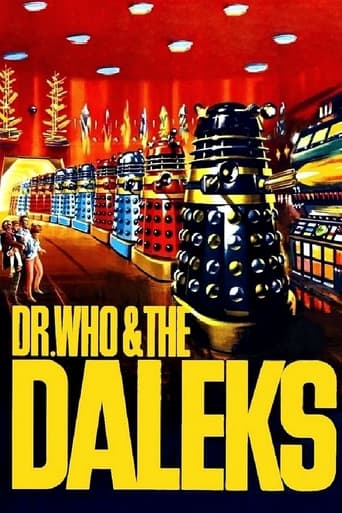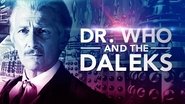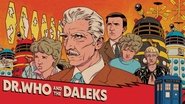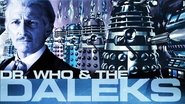utgard14
An elderly scientist named Doctor Who invents a machine that can travel through time and space called the TARDIS. He lives with his two granddaughters, Barbara and Susan. Barbara has a bumbling boyfriend named Ian who accidentally turns the TARDIS on and transports the four of them to an alien planet inhabited by the peaceful Thals and the destructive Daleks. Doctor Who tries to convince the Thals to reclaim their planet before the Daleks detonate a neutron bomb.First things first, we have to put aside comparisons to the TV Doctor Who. There's very little that's similar between the two, even though this movie is based off of one of the earliest stories from the show. The Doctor is human not an alien time lord and his name is literally Doctor Who here, not The Doctor. Judging this by its own merits, I thought it was watchable and sometimes even good. Peter Cushing is enjoyable, as are Jennie Linden and Robert Tovey as his granddaughters. Linden looks quite good in her pink capris. I wasn't crazy about Roy Castle, particularly when he's trying to be funny. It's filmed in a lovely Technicolor, which I always appreciate. The effects and sets may appear cheesy to some today but I think they're very creative and fun, as sci-fi designs usually were back in the day. The music's pretty good, too. This isn't likely to appeal to many modern Who fans but I think people who like Peter Cushing and Amicus will find something to enjoy about this.
James Hitchcock
"Dr. Who and the Daleks" was the first of two Doctor Who films made by Amicus Productions in the mid-sixties; the second was "Daleks – Invasion Earth: 2150 A.D". Both films starred Peter Cushing as Dr. Who, not William Hartnell who was the current television Doctor. Although they make use of many key features of the television series, such as the Tardis (a machine disguised as a police box and capable of travelling in time and space), and the Daleks, the Doctor's most iconic enemies, the films are not generally considered to form part of the official "Doctor Who" canon. Patrick Troughton, who succeeded Hartnell on television, is regarded as the Second Doctor, not the Third. I think the reasons are firstly that no mention is ever made of Cushing's character being a Timelord- he is always assumed to be an eccentric human inventor rather than an alien- and secondly that he does not feature in any "regeneration scene" as all the other Doctors do. The film opens in a setting about as far removed from the hi-tech world of science fiction as one can get, the cramped living-room of a small London house, decorated in a style desperately old-fashioned even by the standards of the 1960s. Dr. Who and his granddaughters Susan and Barbara are proudly showing his latest invention, the Tardis, to Barbara's boyfriend Ian. The accident-prone Ian accidentally activates the machine and the three suddenly find themselves on an alien world which turns out to be Skaro, the home planet of the Daleks. (The name is not actually used in this film, but "Skaro" is the name given in the television series and the second film).The planet is actually home to two races, the aggressive, warlike Daleks and the more peaceful humanoid Thals. (The Thals have much in common with the Eloi in H.G Wells's novel "The Time Machine" and in the film made of it in 1960). We learn that the Thals have not always been so peaceful; at some time in the past a nuclear war, fought between them and the Daleks led to the devastation of the planet, which remains heavily contaminated by radiation. The Thals are able to survive the fallout through the use of anti-radiation drugs, but the Daleks are forced to remain within their city. Because of their previous experiences the Thals have adopted a philosophy of pacifism and refuse to fight back even when threatened by the Daleks, until the Doctor is able to convince them of the soundness of the Just War doctrine. Further elucidation of the plot will probably be unnecessary; anyone familiar with the conventions of "Doctor Who" will realise that it revolves around how the Doctor and his companions assist the Thals to frustrate the evil schemes of the Daleks. This was the first "Doctor Who" story to be made in colour; the TV series continued to be made in black-and-white until 1969. It was also revealed that the Daleks have their own colour-based class system; the leaders are black, secondary commanders red and ordinary Daleks blue. Cushing's characterisation also looks ahead to the future; his Doctor, eccentric but kindly, is quite different to Hartnell's rather testy old man. Some later incarnations of the Doctor, especially Jon Pertwee's Third Doctor and Peter Davison's Fifth, may well have been influenced by Cushing's portrayal. Another feature that predicts the way the programme was to go is the use of humour, something that was increasingly to become a feature of the series in the seventies and eighties. (By the time of Sylvester McCoy's Seventh Doctor, a frequent complaint was that it was becoming too jokey). Roy Castle's Ian is, to begin with, a rather comical figure, clumsy and cowardly, but later he proves to have hidden reserves of courage. Castle, I must say, proved more successful than did Bernard Cribbens who played the equivalent role in "Daleks – Invasion Earth". I also liked Roberta Tovey's sweet young Susan, proof that not all child stars have to be brats. The television series was famous (some might say notorious) for its low budgets, especially in the special effects department, and the film was obviously made in a similar tradition. We only, for example, see the Dalek city from the inside, and what we see seems to have been put together by an enthusiastic Blue Peter presenter out of sticky-backed plastic. Pace George Lucas, however, one does not need a budget the size of a small planet to make effective sci-fi, and "Dr. Who and the Daleks" is really quite an enjoyable good-against-evil adventure story with a loveably eccentric hero in the best British tradition. It lacks the silliness and preposterous plot elements which sometimes marred Daleks – Invasion Earth". Forget all the arguments about whether the film is "canonical" or not. This is really vintage Doctor Who. 6/10
AaronCapenBanner
Peter Cushing is one of my favorite actors, a veteran of many classic horror films, from Hammer Films and Amicus, which produced this theatrical version of my favorite series, an adaptation of the second story, but first Dalek adventure from the TV show, called 'The Daleks', which starred William Hartnell as the Doctor, William Russell as Ian, Jaqueline Hill as Barbara, and Carole Ann Ford as Susan.Here, all the parts are recast, since this does not share the same continuity as the series. How could it? Despite Cushing's likable performance, this film is a pointless and dumbed down version of the brilliant and atmospheric TV original, superior in every way possible. The F/X to this film look more dated than the series, which has aged quite well.Finally saw it on DVD, with a double feature of the sequel.
grendelkhan
I have never understood the rather low esteem the die-hard Who fans give to the Amicus films. I'm a casual Yank fan of the series; I enjoy the series overall, but find individual episodes and portrayals to be very hit and miss. However, I enjoy the heck out of the movies, despite hearing bad things about them before finally encountering Dr. Who and the Daleks on a late night TV broadcast.The films depart from the series in a few respects, mostly in the character background. The Doctor is an eccentric Earth genius who has developed the TARDIS, rather than an alien. He has two granddaughters, Barbara and Susan, where only Susan was a granddaughter in the series (though the 20th anniversary magazine had a story that suggested Susan wasn't a blood relation of the Doctor). In the series, Barbara and Ian are Susan's teachers, who stumble into the TARDIS, after following the odd little girl home. Here, Ian is Barbara's boyfriend, who is shown the TARDIS by the family. Also, the TARDIS interior is vastly different, with the film version looking like a complicated mess of wires, tubes, and equipment, compared to the cleaner and more functional lines of the series. After that, the film pretty much follows the plot of the original Dalek serial.Our explorers are accidentally propelled into the future, and to another planet (Skaro), where they discover a devastated world, as seen in the wonderfully designed petrified forest. They encounter a strange city, where they meet the Daleks, armored apparently robotic creatures who have survived a nuclear holocaust. Later, they will meet the Daleks' foes, the Thals, humanoids who have developed a serum to cure radiation sickness and create immunity. The Doctor and his family join with the Thals to stop the Daleks and their aims of conquest and destruction.The world is wonderfully realized, at times very reminiscent of the 60s, yet also appearing otherworldly and timeless. The exterior of the Dalek city is very evocative of this strange race, while the insides are sleek and functional, as who fit this mechanical race. The Dalek designs are slightly modified from the series, with some of the "plunger" arms replaced by gripper claws, slightly larger dome lights, and wider bases. Also, since the film is in color, we get to see varied designs for the Daleks that weren't available in the original black & white TV broadcast. The petrified forest is an amazing set, with a sandy gray texture and the appearance of a world frozen in time (rather like Pompeii or the petrified forest of Arizona). Watching the film, you feel like you are observing an alien world, not a studio set.The actors are all terrific, with Peter Cushing making a fine Doctor. he was a bit of a departure from the gruffer William Hartnell, but fits right in with the more twinkle-eyed qualities of Patrick Troughton or Tom Baker. It's a lighter portrayal, for sure, but never campy. Jennie Linden makes for a fine Barbara, who gets to muck in with the action, though she is the closest to the standard Who companion, asking lots of questions and screaming at the appropriate moment (though not nearly as much as the television ladies did). Roy Castle adds some comic relief as the slightly bumbling but valiant Ian. Castle proves very versatile and would have made a great hero, had he continued in the sequel. Roberta Tovey is excellent as Susan, the youngest granddaughter. She essays a very mature character, one who combines the seriousness of an adult scientist with the curious nature of a young girl. Susan makes for a great heroine, as she doesn't stand around screaming or whining. She explores and she solves problems. She could have easily have been the main focus of a whole series. The Thals are able assayed by Barrie Ingham and Geoffrey Toone, in the key roles. They are given an odd appearance that does look very 60s, but doesn't scream "The 60s" at you. really, they kind of look like a proto-Glam Rock band.The film offers plenty for everyone, with great sets, costumes, and vibrant colors contrasted with more subdued elements in the petrified forest. The is plenty of mystery to go along with the action and fantastic, presenting something for both child and adult. It has many tense moments and a rousing climax that makes good use of plot points that were introduced along the way.I personally feel that the harsher criticisms of some fans are grounded in fact that they forget this (and the series) was designed for children. As such, many elements are kept simple; but, that helps strip away some of the excess baggage of many sci-fi dramas and lets you focus on the key story elements. The lighter tone helps offset the rather grim nature of the story (a post-holocaust world and a fight for survival), but it never descends into farce. If you enter the film with an open mind, you will find much to entertain you.


 AD
AD









